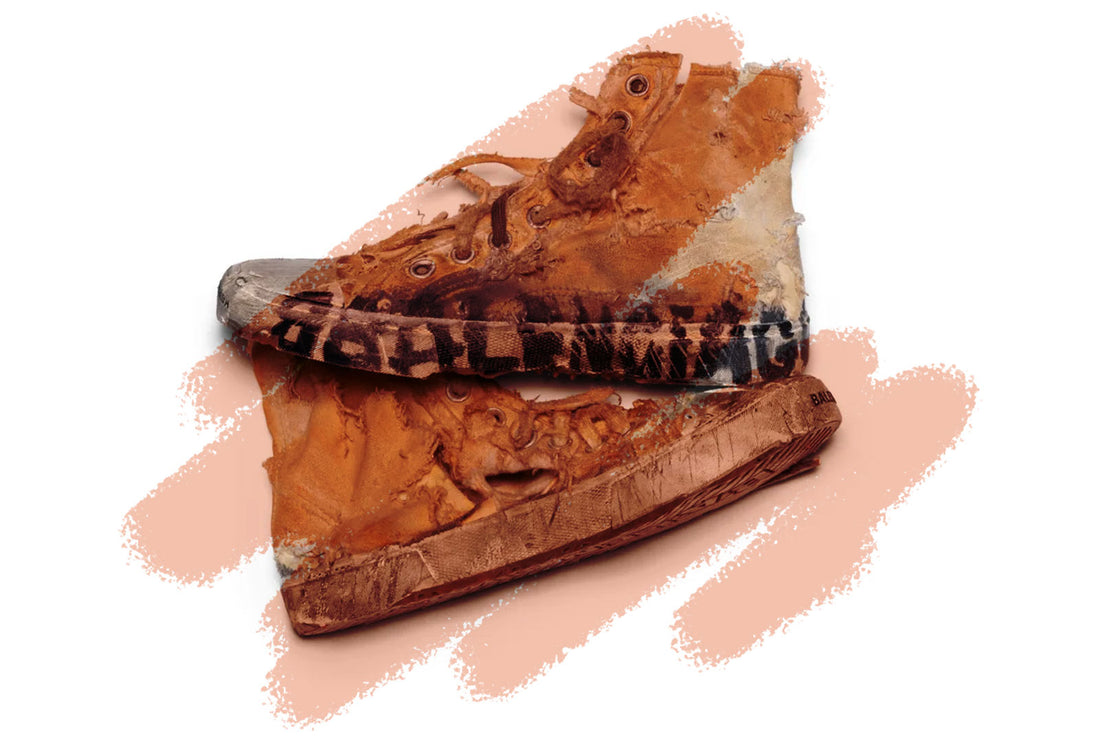At the beginning of May, the fashion house Balenciaga presented this bizarrely destroyed pair of sneakers that are already part of one of the “commandments” of fashion which is to make people talk !
This was undoubtedly another great marketing strategy by its creative director Demna Gvasalia that has been getting us used to these peculiarities. It is about provoking a “mental trigger” that incites us to look for the product and, as a consequence, leads to the evolution of the brand.
All this caused an uproar in the public and subsequently aroused an unusual interest in demand for the brand's goods.
Marketing at its best!
Denma Gvasalia as a refugee from the civil war in Georgia had to find beauty in what he saw, which was a manifest climate of destruction and this made him start to deconstruct the beauty presented on the big catwalks and create a more sloppy and ruined concept where he saw it " The beauty".
This attitude, more than a concept, added positivity to the brand's dissemination.
And the people say that it is wise '' Speak good or bad , but speak of me! ''. Because “speaking”, scrutinizes curiosity and leads to the development of new waves of art, in this case in fashion.
Trends develop in the public the desire to be unique, to have exclusive objects or to have access to restricted series. These trends are criticized, worshiped and/or ignored. All in all, they are one of the greatest additions to the development and success of a brand.
A few years ago, and in all forms of art, artists consecrated themselves through the use of inhospitable and peculiar strategies that fostered creation.
They sometimes presented, in a daring other times ironic way, pieces that sharpened the vanity of having them and of becoming bearers of exclusive or almost unique items , such as their restricted issue.
This made me remember when Madonna came along and quickly became a music and fashion icon.
Due to its irreverence and “shamelessness” both in its presentation and in the controversial and provocative themes it chose, it made it, through the enormous impact it had on culture in the world, the "Queen of Pop".
Madonna is known for her continual reinvention and versatility in music production, songwriting and visual presentation.
He pushed the boundaries of artistic expression in music and created fashions that generated acclaim on the one hand and controversy and criticism on the other. Once again marketing at its finest.
But the powerful force in the creative world is due to many things:
-In the case of Denma Gsvalia, as we have already mentioned, due to the experience of war, he felt the need to refine beauty in destruction, an eclectic form of beauty and environmental sustainability. However, both procedures undoubtedly led to a stir in the art world, with the consequence of opening up new paths and new trends.
The churning of the waters produces a powerful creative force in the world and yet an unexpected appreciation with a reborn look.
Within these new conceptions sustained by the “inversion of luxury”, a new concern now persists, sustainability.
-In the case of Bordalo II, a Portuguese plastic artist, he uses waste and garbage as raw material and transforms them into “masterpieces”, surprising with his large sculptures. One of the examples that has already conquered several cities in the world is the “Big Trash Animals” series, made of tires, bumpers and other debris.
-Deniz Sagdic, of Turkish origin, creates works that look like oil paintings, always using disposable waste victims of abandonment, from jeans, buttons, plastic packaging, etc.
There are those who see in these artists infinite courage and disproportionate encouragement for the use of rubbish and waste as the “new raw material.
And this is where “a star is born”
Deconstruct the destroyed, elevating it to a status of extravagance and beauty.
Talking about sustainability is mandatory, but it is difficult to create a fashion, which is what this blog is about, 100% sustainable, it is !
Of course, any percentage that attenuates the environmental footprint is better than nothing and these dissemination actions certainly help to improve the quality of life on the planet.
Gone are the years when all rags were used and recycled.
The villages farthest from the big cities were almost a happy example of how to recover, recreate and not waste. They were in places so far away that news took years to get there.
An example of this is how everything was used.
Whether in food, whose leftovers either went to the cattle or to fertilize the land, or with the clothes that were used until the "last breath". Those that still had some possibility of being recovered were not buried but reused to make bread bags, towels, clothes for the youngest, floor cloths, kitchen cloths, aprons, ….a paraphernalia of things that in the city no longer exist. they were used since the big markets sold them all new, all cute and with technical innovations that gave them a more efficient use. It was therefore not necessary to tear fabrics, sew them, finish them off and give them a new life. Everything was already appearing on large surfaces with new technologies that made them more effective.
I remember that in the villages of Trás-os-Montes , any scrap was cut into ribbons and either on the loom or by hand, rugs, saddles, hats, blankets, ….even toys were born.
“Sustainable” rag dolls still delight any child today.
As for shoes, when they lost their size, the toecap was cut off and they became “sandals”. They were sent to the shoemaker and with some new covers and soles and a rub with polish, they would shine.
Nothing was wasted.
But with the industrial revolution everything changed.
Machines were born to replace human work and relieve a little of the arduous life we lived. Gradually, with these artifacts, man began to develop industries and commercial and competitive awareness was installed.
But there is no beauty without a flaw and it is now that we are paying the price for being responsible for the “viruses” in the environment.
With the accelerated development of the 20th century and its enormous scientific and technological discoveries, both industry and commerce were transformed in an incredible way and increased productivity immeasurably.
All these blessings have radically altered people's lives and we are faced with a frantic, highly competitive world full of fast-paced people.
But, for me, the biggest pillar of sustainability is culture. Only with a lot of information will it be possible to modify mentalities.
The fashion market is characterized by the short life cycle of articles. Every season thousands of proposals have to be presented because the motivation of fast fashion is enormous.
It is therefore essential to change consumers' mindsets, to make them understand that they will have to adopt a more environmental awareness and awaken in them the need to value less polluting manufacturing.
Taking important actions such as buying less and investing in more durable parts, repairing damaged parts, donating and exchanging or sharing and customizing, are principles that must be rooted in our behavior.
With all this it is crucial that consumer practices adjust to current environmental commitments.
It's not easy since the offer is huge and makes them want to buy without criteria. “Desire leads to the unbridled purchase of pieces that sometimes never made it out of the packaging. They often have to face the internal conflict between desire, provoked by the rapid changes in trends and the decrease in purchasing power.
Therefore, I believe that it is through education and culture that old habits will be changed. I believe that if we become aware of the urgency of recycling, we give the planet time to reforest itself.
Recycling is the pill for sustainability.
At Paris haute couture fashion week, names such as Ronald van der Kamp, Victor & Rolf, Maison Margiela and others, presented collections of 100% sustainable materials and, in addition to recovering clothes from old collections, exhibited pieces made with leftover stocks .
Victor & Rolf, with these presentations, praised the idea that crises of scarcity of materials provoke innovation and creativity.
Maison Margiela and John Galliano, with their eloquent mastery of execution, recovered and displayed wardrobe classics using patchwork and second-hand materials with the intention of giving new meaning to the pieces.
Martin Margiela, the king of deconstructivism, dismantled pieces of clothing and then reconstructed them, increasing their proportions, fascinating and affirming a new trend.
This is, for now, an example of several paths to follow, but there is still much to be done, to study, educate and especially to make people aware that the planet is seriously ill and that if some solutions for the cure have already been found, the truth is that the healing depends on the contribution of all of us.
Science and technology play a leading role, but if they don't have followers, they will never achieve their goal.
Sustainability needs to grow in the heart, move to the brain and only then should it be consciously transformed into a business.
Maria Pia

